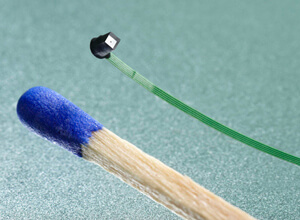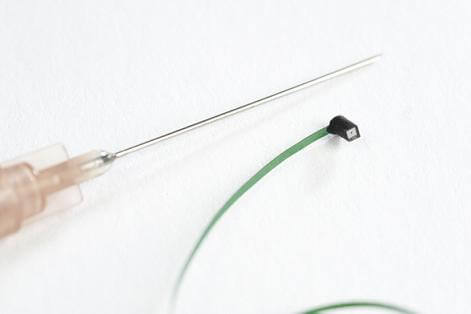
Thanks to a German research institute, in the very near future, we may not even see the cameras looking back at us at all.
It may not be news that camera technology is getting smaller, but it is newsworthy when an important milestone is reached. Take the announcement from the German Fraunhofer Institute for Reliability and Microintegration for example. They recently reported the development of a camera with a lens attached that is 1 x 1 x 1.5 millimeters in size, which is the size of a grain of salt. At about a cubic millimeter in size, this camera is right at the size limit that the human eye can see unaided. The camera not only produces decent images but it is also very cheap to manufacture…so cheap in fact that it is considered disposable. Though researchers developed the camera in collaboration with the Portuguese company Awaiba, the makers of digital camera sensors, for use in medical endoscopes to view all the nooks and crannies inside the body, other applications in electronic devices are already foreseen. There’s even speculation that auto makers may utilize these microcameras as replacements for side mirrors in next-gen cars. And, of course, every government interested in keeping a closer eye on its citizens but doesn’t have a lot of cash…ahem…will probably be watching this technology closely.
It’s clear that the Fraunhofer researchers didn’t set out to hit this milestone in camera technology. What they were really interested in was trying to improve upon endoscope technology. An endoscope involves a camera at the tip of a tube. The tube contains a wire that transmits the image back to a computer. The tube also serves as a way to physically manipulative the camera to snake it through the gastrointestinal tract, for instance. Typical endoscopes cost around $25,000-30,000 so they must be reused many times. Because the endoscope is going in and out of people’s bodies, it must be cleaned and sterilized between each use, which just drives up the cost of maintaining the instrument. It’s no wonder that hospitals charge more than $2,000 per endoscopy.
All of this, however, would change if the camera was cheap enough to throw away.

To accomplish this, the Fraunhofer researchers worked with Awaiba to redesign the endoscopes. Typical endoscopes have a lens at the tip but the sensor that converts the image into a digital signal is at the other end of the tube. Ideally, the lens and sensor should be close together so that they have direct electrical connections, which would help make the camera smaller. But previous designs forced connections between the lens and the sensor to be done individually rather than in a batch process because of the sensor’s design. This is an expensive and time consuming process. The sensors are made on a wafer and previously each wafer would be diced up into 28,000 individual sensors so that the lenses could be attached. What the Fraunhofer researchers accomplished was to redesign the sensors, allowing the connections to be made on the back of the sensor rather than on its side. This means that a wafer of lenses could be mounted and electrically wired to the wafer of sensors, then the stack could be broken into 28,000 devices. The result is that the each microcamera can be made incredibly small for much less than before.
So how good is the camera? For endoscopy, pretty good. The resolution is 62,500 (250 x 250) pixels and can produce a frame rate of 44 per second at this resolution. That’s not exactly the “razor-sharp” pictures as claimed by the press release, but for endoscopy, it fits the bill. Now compared to an iPhone camera, which also contains a CMOS sensor but records nearly a million pixels at 30 frames per second, the Awaiba sensor is not yet ready to be in cell phones. Clearly this camera is still in the prototype stage, but researchers claimed that a disposable endoscope will be available in 2012. It is only a matter of time before the technology becomes more widespread and even cheaper to produce.
What makes this device such a landmark in the storyline of camera technology is that it is right on that uncomfortable verge of becoming invisible to the naked eye, and that is both good and bad. The good news is we can expect to see this or similar camera technology find its way into very compact electronic devices, making the two-way wrist TV of Dick Tracy fame a very near reality. The bad news is that this type of camera technology could usher in a surveillance society that would put the current Orweillian UK, with its 69 CCTV cameras for every 1,000 people, to shame. Fortunately, wi-fi chips are still chunky compared to these cameras, with typical wi-fi chips being ten times larger in size. But it is only a matter of time before wi-fi chips reach the grain-of-salt milestone and then the age of inexpensive, invisible wireless cameras will be upon us. Yikes.
[Image credit: Awaiba]
[Sources: Awaiba, Discovery, Fraunhofer Institute]



